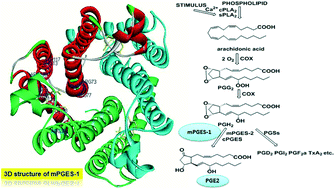Targeting microsomal prostaglandin E2 synthase-1 (mPGES-1): the development of inhibitors as an alternative to non-steroidal anti-inflammatory drugs (NSAIDs)
Abstract
Prostaglandin E2 (PGE2) is an important substance in diverse human organs and regulates a variety of physiological and pathological processes, such as inflammation, fever, pain and cancer. Microsomal prostaglandin E2 synthase-1 (mPGES-1), a glutathione (GSH)-dependent enzyme, can induce the generation of PGE2. Since the 1990s, scientists have been studying the biochemistry and pathophysiology of mPGES-1, proposing it to be a promising target for the treatment of PGE2 metabolic abnormalities. Nevertheless, selective mPGES-1 inhibitors have not been available in clinics up to now, and studies on mPGES-1 are rare. Unlike non-steroidal anti-inflammatory drugs (NSAIDs), mPGES-1 inhibitors can reduce PGE2 production without affecting the generation of other PGs and thromboxane (Tx), indicating fewer side effects of mPGES-1 inhibitors. Recently, many chemical substances obtained from natural plants, human endogenous substances and chemical synthesis have been demonstrated to have strong inhibitory effects on mPGES-1. Here, we mainly review studies on mPGES-1 biology and mPGES-1 inhibitors along with their chemistry, biological activity and docking algorithm of computer-aided molecular design in the past decade.


 Please wait while we load your content...
Please wait while we load your content...